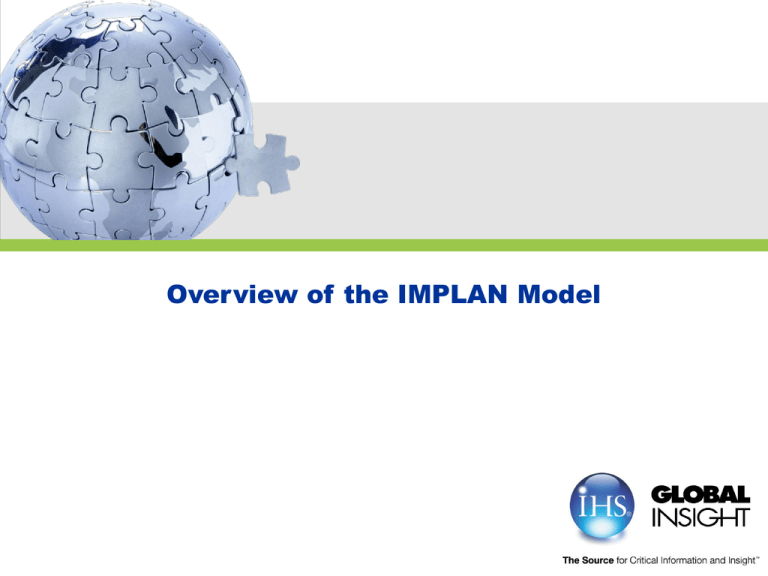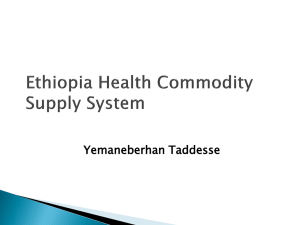
Overview of the IMPLAN Model
Agenda
IMPLAN Review
IMPLAN Case Study
Understanding Regional Differences in IMPLAN
Copyright © 2009 IHS Global Insight. All Rights Reserved.
What is Economic Modeling and IMPLAN
Analysis of the impact of an activity, from an industry to event, on the overall economic
structure, measured in total employment, output and value added.
IMPLAN is an Input-Output/Social Accounting Matrix tool
– IMPLAN is a production model; that is, it evaluates how businesses respond – i.e.,
what the “impacts” are - to demand for their products and services
– A Social Accounting Matrix (SAM) represents flows of all economic transactions that
take place within an economy
– Enables determination of specific multipliers for the project
– Multipliers measure how much a type of output changes in response to a change in input
– i.e. – for each new employee directly involved, a project with a 1.5 employment multiplier
will add an additional 0.5 employees through downstream impacts
– Creates picture of local economy
• Producers who make things and consumers who buy them
• Complete accounting picture of money flows
• Models can be at National level, state, county, zip code or a combination of
regional models
– Create predictive model based on that picture
• Captures backward linkages
• Leakages limit size of multipliers
– IMPLAN widely used in economic impact analysis
• USDA uses IMPLAN to monitor job creation from ARRA
Copyright © 2009 IHS Global Insight. All Rights Reserved.
What Data Does IMPLAN Contain
IMPLAN covers 440 industries, containing data on:
–
–
–
–
Total Industry Output (gross sales)
Employment (average annual full- & part-time jobs)
Value Added
Employee Compensation (wages, salaries, other labor income, employer & employee
contributions to social insurance)
– Proprietors Income (sole proprietorships, self employed)
– Other Property Income (dividends, interest, rent)
– Indirect Business Taxes (sales, gasoline, excise taxes, custom duties, fees collected by
businesses)
For Institutions:
– Household Consumption (PCE for 440 commodities)
– Government Consumption (Federal Military & Non-Military, State & Local Government,
Education & Non-Education for 440 commodities)
– Capital Investment & Inventory Additions (for 440 commodities)
– Institutional Sales (HH used goods, Government sales, sales of inventory)
For Trade:
– Foreign Imports & Exports (for 440 commodities)
– Domestic Imports & Exports (gross trade flows county-to-county for 440 commodities)
– Regional Purchase Coefficients (rate of local purchase of 440 commodities)
Copyright © 2009 IHS Global Insight. All Rights Reserved.
Industries vs. Commodities in IMPLAN
IMPLAN model inputs need to be classified as either an Industry or a
Commodity
– All final demands in the original data are on a commodity basis. The
distinction between industries and commodities is as follows from the
1972 I-O Definitions and Conventions Manual:
• An input-output industry is a grouping of establishments, as classified by
SIC;
• An input-output commodity consists of the characteristic products of the
corresponding I-O industry wherever made.
In application, inputs should be classified as commodities if the
transaction is retail based
– Commodity transactions apply a margin to the transaction to reduce
the gross purchase to the retail trade margin amount only
If it is known that other components of supply chain (product, transport,
wholesale) occur in the study area, the value of those components
should be split off from the transaction into their own event
Copyright © 2009 IHS Global Insight. All Rights Reserved.
Economic Impact Definitions
Economic Impacts
– Direct Effect
• Direct effect refers to the response of the economy to the change in the final
demand of a given industry, refers to those directly involved in the activity.
– Indirect Effect
• Indirect effect refers to the response of the economy to the change in the final
demand of the industries that are dependent on the direct spending industries
for their input, also known as the supplier effect.
– Induced Effect
• Induced effect refers to the response of the economy to changes in household
expenditure as a result of income generated by the direct and indirect effects, also
known as the income effect.
Value Added
– Value added is payment to labor and capital used in the production of an industry. It
is defined as the sum of labor income, indirect business taxes and business income.
Copyright © 2009 IHS Global Insight. All Rights Reserved.
IMPLAN’s I/O Tables Overview
EXPENDITURES
Industries
Industries
Commodities
Commodities
Factors
Households
Governments
Capital
MAKE
USE
CONSUMPTION
CONSUMPTION
INVESTMENT
Trade
TOTALS
EXPORTS
Industry
Output
Commodity
Output
R
Columns
4, 5, 6 represent
payments by Column 7 represents payments
VALUE
Column 2 all
represents
Column 3 represents
all the Factor
factor
Column 1 represents
Factors
ADDED
Receipts
E
institutions to commodities
or other by foreign and domestic exports
by Commodities:
income distributions:
the paymentspayments
by Industry:
DISBURSTAXES &
EXTERNAL
Household
institutions
(the
rows
represent
imports):
C
Households
SALES
TRANSFERS
TRANSFERS
They are
made
There
in industries
are
value added
They buy
commodities
MENTS
TRANSFERS
INCOME
Receipts
(rowsI 4 – 6 represent income by institution): There are commodity exports
They
are
sold
distributions
to institutions
to institutions
Add& valueTRANSFERS
from
factories
DISBURSTAXES
EXTERNAL
Government
Governments
SALES
TRANSFERS
There are
final demands by institutions
MENTS Institutional
TRANSFERSexports
SERVICES
Receipts
Foreign and Domestic
trade
Buy imports
E
Inter-institutional
transfers
Trans-shipments
DISBURSTAXES & are goods
NET
Capital
The Commodity
factor
equals
imports
Capital
SALES
TRANSFERSOutlay
Pay forTRANSFERS
employment
MENTS
TRANSFERS
INVESTMT
Receipts
P
Foreign
and domestic imports to final
shipped
into
US and back out
total commodity output
TRANSTrade
T
demand
Trade
IMPORTS
IMPORTS
IMPORTS
IMPORTS processing
IMPORTS
without further
SHIPMENTS
Receipts total
The Factor
Outlay equals
The Industry
Outlay equals
S
Industry
Commodity
Household
Government
Trade
payments
total industry
outputCapital factor
TOTALS
Factor Outlay
Outlay
Outlay
Outlay
Outlays
Each Institutional
Outlay
column represents
The total represents
totalOutlay
foreign Outlays
totalEmployment
expendituresJOBS
by institution
and domestic trade
The initial data set is "use" of commodity by industry (the Expenditures), and the "make" of commodities
by industry (the Receipts).
Based on national I/O model, converted to regional area based on regional industry makeup and
adjusting purchasing and output ratios
–
The SAM tracks the dollar flows through the economy as sets of income and payments. Each row and
column balance exactly so all flows are counted.
Copyright © 2009 IHS Global Insight. All Rights Reserved.
IMPLAN’s I/O Tables Overview
EXPENDITURES
Industries
Industries
Commodities
Commodities
Factors
Households
Governments
Capital
MAKE
USE
CONSUMPTION
CONSUMPTION
INVESTMENT
Outlay
Outlay
Outlays
Trade
TOTALS
EXPORTS
Industry
Output
Commodity
Output
R
VALUE
Factor
Factors
ADDED
Receipts
E
DISBURSTAXES &
EXTERNAL
Household
C
Households
SALES
TRANSFERS
TRANSFERS
MENTS
TRANSFERS
INCOME
Receipts
I
DISBURSTAXES &
EXTERNAL
Government
Governments
SALES
TRANSFERS
TRANSFERS
MENTS
TRANSFERS
SERVICES
Receipts
E
DISBURSTAXES &
NET
Capital
Capital
TRANSFERS
TRANSFERS
Social
accounts
track all SALES
monetary
flows TRANSFERS
between
industries
and institutions.
MENTS
INVESTMT
Receipts
P
TRANSTrade
T
Trade
IMPORTS
IMPORTSwas purchased
IMPORTS
– Represents
all thingsIMPORTS
that areIMPORTS
made, what
to make
it, andReceipts
who
it
SHIPMENTS
S was sold to Industry
Commodity
Household
Government
Capital
Trade
TOTALS
Outlay
Outlay
Factor Outlay
– Covers
all end
users as well, and where their expenditures go
Employment
JOBS
Outlays
The backward and forward linkages enable the direct, indirect and induced
effects to be determined for a given input
– By tying in all the expenditures and receipts for any one industry, the complete
economic picture is created and can be modeled
Copyright © 2009 IHS Global Insight. All Rights Reserved.
IMPLAN Sectors Can Be Mapped Back to
NAICS Codes At Varying Levels of Detail
Snapshot of IMPLAN Sector Map
• The NAICS standard was
adopted in 1997 to replace SIC
codes
• Go from primary 2 digit
categories down to 6 digit
level of detail
• IMPLAN sectors based on the
BEA Input-Output Study
• IMPLAN maps very
closely to 6 digit NAICS for
manufacturing
• More aggregate for
service sectors
• Construction one of few
main sectors not directly
corresponding to NAICS
• Each IMPLAN sector has
varying factors for how inputs
flow through the local economy
• Choosing the correct sector
therefore increases the accuracy
of the model
Copyright © 2009 IHS Global Insight. All Rights Reserved.
IMPLAN
Sector
242
243
244
245
246
247
248
249
250
251
252
253
254
255
256
257
258
259
260
261
262
263
264
265
266
267
268
269
270
271
272
273
274
275
IMPLAN Description
Bare printed circuit board manufacturing
Semiconductor and related device manufacturing
Electronic capacitor, resistor, coil, transformer, and other inductor manufacturing
Electronic connector manufacturing
Printed circuit assembly (electronic assembly) manufacturing
Other electronic component manufacturing
Electromedical and electrotherapeutic apparatus manufacturing
Search, detection, and navigation instruments manufacturing
Automatic environmental control manufacturing
Industrial process variable instruments manufacturing
Totalizing fluid meters and counting devices manufacturing
Electricity and signal testing instruments manufacturing
Analytical laboratory instrument manufacturing
Irradiation apparatus manufacturing
Watch, clock, and other measuring and controlling device manufacturing
Software, audio, and video media reproducing
Magnetic and optical recording media manufacturing
Electric lamp bulb and part manufacturing
Lighting fixture manufacturing
Small electrical appliance manufacturing
Household cooking appliance manufacturing
Household refrigerator and home freezer manufacturing
Household laundry equipment manufacturing
Other major household appliance manufacturing
Power, distribution, and specialty transformer manufacturing
Motor and generator manufacturing
Switchgear and switchboard apparatus manufacturing
Relay and industrial control manufacturing
Storage battery manufacturing
Primary battery manufacturing
Communication and energy wire and cable manufacturing
Wiring device manufacturing
Carbon and graphite product manufacturing
All other miscellaneous electrical equipment and component manufacturing
IMPLAN Sector
244 maps only
to 3 6 digit
NAICS codes,
from 334414-6
IMPLAN Sector
259 maps only
to 5 digit NAICS
code 33511
2007 NAICS
334412
334413
334414-6
334417
334418
334419
334510
334511
334512
334513
334514
334515
334516
334517
334518-9
334611-2
334613
33511
33512
33521
335221
335222
335224
335228
335311
335312
335313
335314
335911
335912
33592
33593
335991
335999
Agenda
EIA and IMPLAN Review
IMPLAN Case Study
Understanding Regional Differences in IMPLAN
Sunfab Economic Impact Review
Challenges and Opportunities Going Forward
Copyright © 2009 IHS Global Insight. All Rights Reserved.
Case Study – Impact Results
The same $1M input
(Economic Output) produces
over $80k in
Indirect Professional
value in
FL,
Example: $1M of spending in IMPLAN Sector 35 – Construction of new nonresidential Services
manufacturing
structures
compared to $55k in NC
Florida
North Carolina
The same investment produces 7% greater output in FL than NC
– Major industries (ranked by total output) remain largely consistent, as expected
– Regional differences do alter the rankings and weightings, creating the variation
between output totals
Copyright © 2009 IHS Global Insight. All Rights Reserved.
Case Study – Impact Results
The same $1M input
(Employment)
produces .27 employees
in Admin Services in FL,
to .18structures
in NC
Example: $1M of spending in IMPLAN Sector 35 – Construction of new nonresidentialcompared
manufacturing
Florida
North Carolina
The total employment effect is higher in NC than FL
– Direct employment higher in NC than FL due to lower avg. industry wages
– As with output, downstream impacts higher in FL than NC
Copyright © 2009 IHS Global Insight. All Rights Reserved.
Agenda
EIA and IMPLAN Review
IMPLAN Case Study
Understanding Regional Differences in IMPLAN
Sunfab Economic Impact Review
Challenges and Opportunities Going Forward
Copyright © 2009 IHS Global Insight. All Rights Reserved.
Case Study – Regional Comparisons
(Understanding What Drives Regional Differences)
Florida
North Carolina
Core Implan industry data highlights regional differences within the same sector
– FL construction industry significantly larger than in NC
– While output per employee is slightly higher, avg wage much higher
– Value Add % is sum of Value Add components/Output
Copyright © 2009 IHS Global Insight. All Rights Reserved.
Case Study – Regional Comparisons
Construction of New Nonres Manufacturing Structure - 35
Regional industry variations generate
differing levels of value add
Variations in absorption coefficients
determine where indirect impacts
result
Absorption Coefficient is the fraction of
each industry's outlay spent on each
type of commodity in the study area
– For every $1 in output in NC for
sector 35, $0.027 of Petroleum
Refineries in NC is used as indirect
output
– That industry then has its own value
added % and industry relationships
which determine the final indirect
output from the original spending
Copyright © 2009 IHS Global Insight. All Rights Reserved.
NC
FL
Petroleum Refineries
0.027
0.025
Clay and nonclay mfg
0.015
0.014
Concrete Manufacturing
0.014
0.013
Architectural Metal
0.015
0.014
Other fabricated metal
0.020
0.018
Other general purpose machinery
0.053
0.049
Light Fixture mfg
0.071
0.065
Wholesale trade
0.046
0.042
Commercial and Industrial Machinery
0.014
0.013
Legal Services
0.017
0.016
Architectural and Engineering services
0.042
0.039
Other Industries
.0178
0.167
Total Absorption
0.5115
0.4747
Value Added Coefficient
0.4885
0.5253
Case Study – Regional Comparisons
North Carolina
Commodity data highlights how regional demographic groups allocate their
consumptions
Regional variations drive the induced effects
Copyright © 2009 IHS Global Insight. All Rights Reserved.
Thank You
John Barrett
Senior Consultant
IHS Global Insight
john.s.barrett@ihsglobalinsight.com
781-301-9274
Shane Norton
Senior Consultant
IHS Global Insight
shane.norton@ihsglobalinsight.com
781-301-9071
Copyright © 2009 IHS Global Insight. All Rights Reserved.










